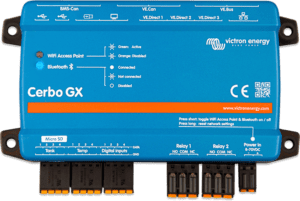
Battery monitoring on our vessels is an obsession comparable to keeping an eye on the wind indicator and the sail telltales. With all of us skippers fussing over slight changes in battery charge several times a day while on passage, we would expect a horde of manufacturers pandering to us with battery monitoring systems compatible with our chartplotters, right?
Nope! Of all the marine and recreational battery monitoring systems on the market, only one offers compatibility with our chartplotters: the Victron Cerbo GX, “a hub for all energy on board.”
To be sure, other monitoring systems have jumped straight ahead to cellular apps, using Wi-Fi and Bluetooth technology to keep us informed of battery charge and the overall performance of our onboard electrical systems. Balmar, Xantrex, Siren Marine, Oceanic Systems, Naut Alert and other manufacturers offer dependable battery monitoring systems, complete with shunt and wireless connections, providing detailed data on battery charging and performance.
These are all great systems, but who keeps a cellphone propped up at the helm 24 hours a day while on passage offshore? Cellphones are great while cruising close to home, but when we take the helm on a long crossing in rough weather, our eyes stay on either the compass or the chartplotter, which offers us multiple screens primarily for navigation.
The center of the Cerbo GX is a small, blue box, or hub, with eight analog inputs for temperature readings, depth sounder, water and fuel tank levels, etc., plus four digital inputs for battery charge monitoring. With four battery sensors, you can keep tabs on the starter battery, house bank and two reserve banks from a single screen on your chartplotter while on passage.
If you still need connectivity to the cloud, you can use the Cerbo GX as a Wi-Fi server in the same manner as its competitors. In order to connect to the internet, you will need access to a Wi-Fi or LAN network, or a GX GSM network.
While you are away from the vessel, you can use the Cerbo GX internet connection to keep yourself apprised of battery charge, which offers clues to other electrical activity occurring on your floating palace during your absence.
If you are 200 miles inland on a road trip and you notice a sudden charge drop in one of your house batteries, this could indicate a spontaneous, unexplained firing up of your electrical system, or just as bad if not worse, a short that could cause a fire.
A sudden drop in the starter battery charge, followed by a surge, could mean your yacht is in the hands of a nefarious, ill-intentioned intruder—a pirate! Battery charge fluctuations are a key source of information on the overall health of your vessel while underway or in your home port.
The Cerbo GX from Victron Energy is compatible with virtually all chartplotters, including Furuno, Raymarine, Garmin, Lowrance/B&G/Simrad and Navico. At roughly $340, it is hard to imagine a more sensible investment for your vessel’s battery management system.
Circumnavigator-author Bill Morris believes the best strategy for succeeding as an offshore voyager is to keep systems simple and, if possible, manual. Key to survival are a windvane self-steering system, a basic array of electronics and an aggressive alternative energy battery charging matrix. Bill is a frequent contributor to Ocean Navigator and the author of The Windvane Self-Steering Handbook (International Marine, 2004) and The Captain’s Guide to Alternative Energy Afloat (Seaworthy Publications, 2019).
